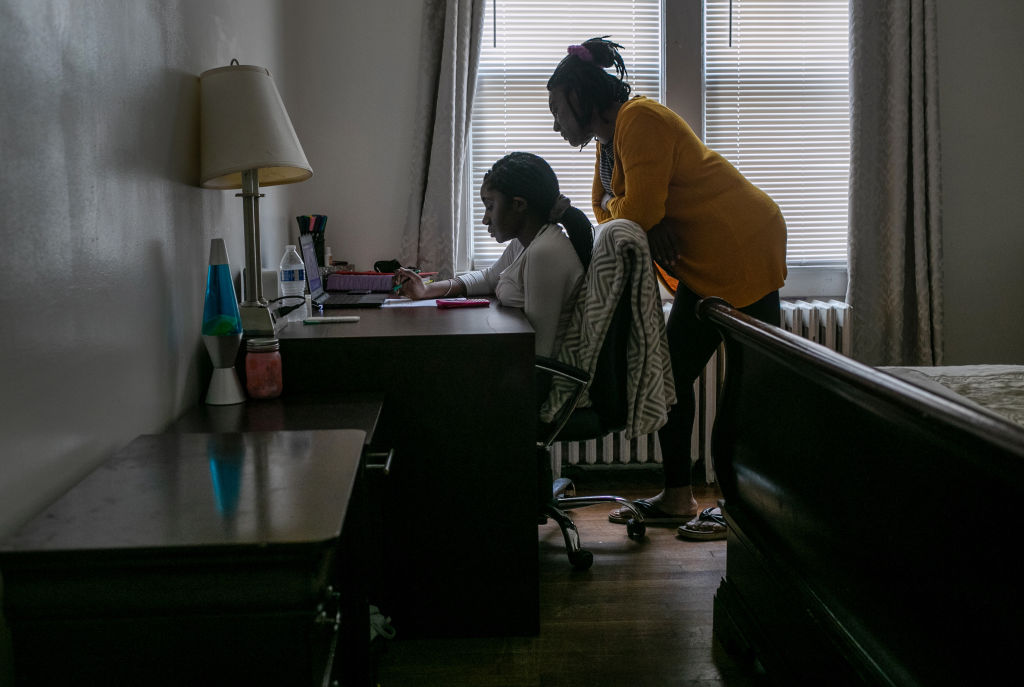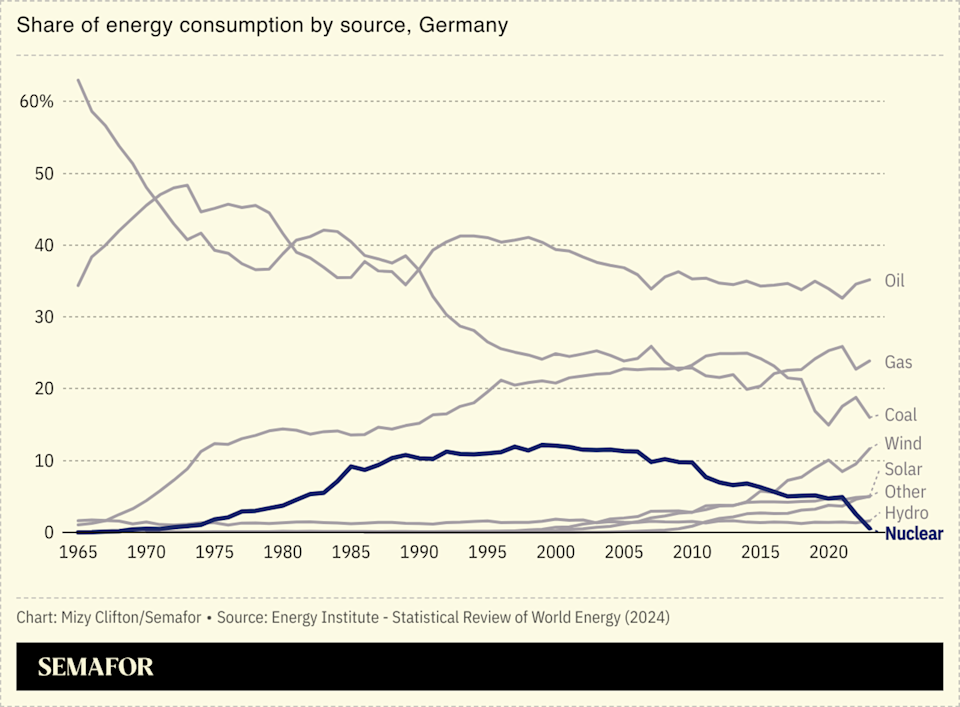
STAMFORD, CONNECTICUT – OCTOBER 28: Abigail Previlon, 13, takes part in remote distance learning on a Chromebook with the help of her mother Carlene at home on October 28, 2020 in Stamford, Connecticut. Previlon is hearing impaired and has a translator for in-class learning and while distance learning on a Chromebook. Students with special needs have additional educational challenges due to the Coronavirus pandemic. A first generation American citizen with Haitian parents, Previlon is fluent in four languages, including English, French, Creole, and sign. Stamford Public Schools is currently using a hybrid educational model due to the Coronavirus pandemic, with a combination of in-class and distance learning. (Photo by John Moore/Getty Images)
A massive federal program meant to expand broadband access to underserved areas across the country is falling behind schedule, state broadband officials and experts say, even as Trump administration actions create further uncertainty about its funding and rules.
Now in its third year, the Broadband Equity, Access, and Deployment Program, known as BEAD, is largely still in the planning phase.
Advertisement
Advertisement
In Alpine County, California, the vice chair of the county Board of Supervisors, David Griffith, said he is still waiting to see how BEAD funds will help his area. Out of the county’s roughly 1,100 residents, most rely on phone lines to connect to the internet and can’t afford high-speed connections.
That means instead of renewing their driver’s licenses online, for example, many of the county’s residents drive 30 miles to the closest department of motor vehicles location, he said. They lack internet speed for telemedicine, banking and tax filing.
“We all want government to work,” Griffith said, “and unfortunately, the BEAD program is an example where the need is there and the funding is there, but it’s just a very inefficient process.”
Congress awarded California $1.8 billion to ensure households get access to high-speed internet as part of the $42.45 billion BEAD program, created under the Infrastructure Investment and Jobs Act of 2021.
Advertisement
Advertisement
All 50 states have had their initial proposals approved, unlocking a portion — often 20% — of the money the feds will provide. Delaware, Louisiana and Nevada are the only states to have submitted their final proposals.
Some local officials and experts are questioning the efficiency of the program. Progress is slow in part, they say, because of inadequate federal mapping of where broadband is most needed and a lengthy challenge process to the maps. And some experts worry that states are favoring overly expensive infrastructure.
The BEAD program is an example where the need is there and the funding is there, but it’s just a very inefficient process.
– David Griffith, Alpine County, Calif., supervisor
Federal and state broadband officials are also waiting to see how President Donald Trump’s funding freeze may affect the BEAD program, as well as how federal officials might change an affordability requirement or the type of technologies given preference under the program.
Advertisement
Advertisement
At his confirmation hearing, U.S. Secretary of Commerce Howard Lutnick, who took office Feb. 19, said he supported the goals of BEAD but wanted to make sure it was done “efficiently and effectively” and sidestepped questions asking him to commit to sending money out to states.
Griffith said he’s hopeful the money will still flow, noting that most of BEAD’s funds will go to rural areas, many of which tend to elect and support Republicans.
State snags
Louisiana was the first state to have both its initial and final BEAD proposals approved by the National Telecommunications and Information Administration (NTIA).
The state plans to deploy more than $1.35 billion in funding through its GUMBO 2.0 program. States grant the federal money to internet service providers, local governments, nonprofits and other groups to build out the infrastructure.
Advertisement
Advertisement
Shortly after the state’s plans were approved in January, Louisiana Republican Gov. Jeff Landry sent a letter to the Commerce Department asking for changes within NTIA and the BEAD program, including a request to streamline the agency’s requirements and a commitment to more timely and transparent funding reviews.
NTIA declined to answer Stateline’s questions about the BEAD program.
Officials in some states have run into snags with challenges to the Federal Communications Commission’s National Broadband Map.
Through the map challenge process, local governments, internet service providers, nonprofits and other groups can help determine whether a particular location actually has internet service.
Advertisement
Advertisement
Griffith, the California county supervisor, said the map was originally “full of errors” in his area.
“We went through it in Alpine County, and about 7-8% of residences and businesses were left off of the National Broadband Map,” he said. “Unless you’re on the National Broadband Map, that money cannot be used to connect your home or business.”
The BEAD program also has an affordability requirement that mandates state broadband officials include a low-cost service option for low-income households. But industry groups have pushed back, calling the rule “completely unmoored from the economic realities of deploying and operating networks in the highest cost, hardest-to-reach areas.”
The BEAD program has “moved a little slower than it should have,” said Sachin Gupta, the vice president of business and technologies strategies at Centranet, part of the Central Rural Electric Cooperative in Oklahoma. The group serves households living just outside of Oklahoma City.
Advertisement
Advertisement
“There are people who cannot do remote work, or distance learning, or be part of the digital economy or do telehealth and telemedicine,” he said. “So, there’s real-world consequences.”
In August, the feds approved Oklahoma’s initial BEAD proposal, allowing the state to request access to over $797 million.
The goal is to get households connected to the internet as quickly as possible, but there are going to be some challenges, such as mapping, Gupta said.
“This work has gone on for some time,” Gupta said, “but if you pull this money back, people are just going to be even more distressed than they were before.”
Technology choices
Experts at the Information Technology & Innovation Foundation, a science and technology policy think tank based in Washington, D.C., have argued that the BEAD program favors overly expensive broadband infrastructure.
Advertisement
Advertisement
Fiber-optic internet, which BEAD gives preference to, is considered faster and more reliable than other methods of connection, but other technologies, such as satellites, could be more cost-effective, according to the group. The money saved from using less costly infrastructure could be put toward affordability efforts instead.
“That may be the best kept secret: The reason people aren’t online anymore is not about broadband being unavailable,” said Joe Kane, the director of broadband and spectrum policy at the foundation. “It’s that they can’t afford it.”
In states like Nevada, where officials are planning to spend about $77,000 per business or residential location to deploy fiber, there’s not going to be much money left over for affordability efforts, Kane said. It’s even more crucial now that the Affordable Connectivity Program, a pandemic-era discount program for low-income households, has dissolved.
“I think the most important thing for broadband overall is that we should be trying to take a data-focused approach to what are the real causes of the digital divide, and how is our broadband policy meeting that,” Kane said. “Because right now, we have a complete mismatch.”
Advertisement
Advertisement
But Gupta, who has been involved with Oklahoma’s broadband expansion for years, said other types of broadband internet cannot provide the same internet speed as fiber.
“If we deploy technologies that are not scalable, then all we’re doing is kicking that can down the road another five years.”
Affordability concerns
As consumer prices rise, internet affordability is a significant concern, said Derrick Owens, the senior vice president of government and industry affairs at WTA — Advocates for Rural Broadband. The group represents small, rural telecommunications providers across the country.
Alongside federal broadband programs, some states have worked to expand broadband access by passing new laws. As of Feb. 24, lawmakers in 43 states had filed a total of 300 bills regarding broadband access, infrastructure, affordability and more, according to the National Conference of State Legislatures broadband legislation database.
Advertisement
Advertisement
Three of those states — Connecticut, Minnesota and New York — are hoping to improve the process of mapping which areas need better internet service.
This year, lawmakers in 10 states — Connecticut, Indiana, Maryland, Mississippi, Missouri, Nebraska, New Jersey, New Mexico, New York and Virginia — have filed legislation to expand broadband access to rural areas.
“If you don’t have access to broadband today on a permanent, full-time basis, then you’re not able to participate fully in today’s economy,” Owens said. “And it’s not just the local economy, it’s the global economy. And so, the efforts are being made to make sure people have high-speed, quality, reliable broadband, and hopefully that’s what BEAD brings.”
Stateline is part of States Newsroom, a nonprofit news network supported by grants and a coalition of donors as a 501c(3) public charity. Stateline maintains editorial independence. Contact Editor Scott S. Greenberger for questions: info@stateline.org.
EMEA Tribune is not involved in this news article, it is taken from our partners and or from the News Agencies. Copyright and Credit go to the News Agencies, email news@emeatribune.com Follow our WhatsApp verified Channel





